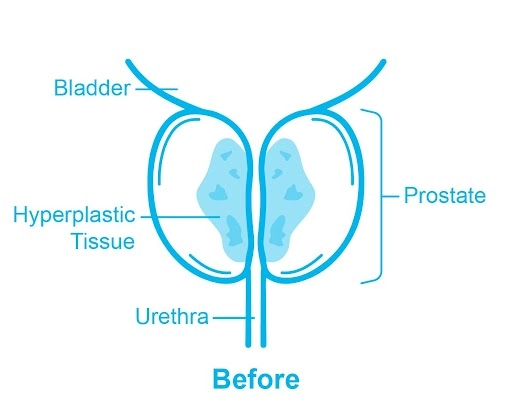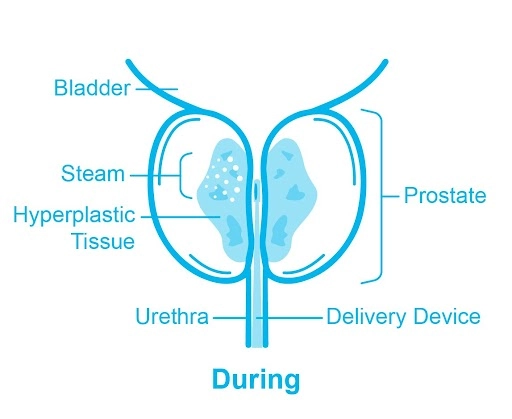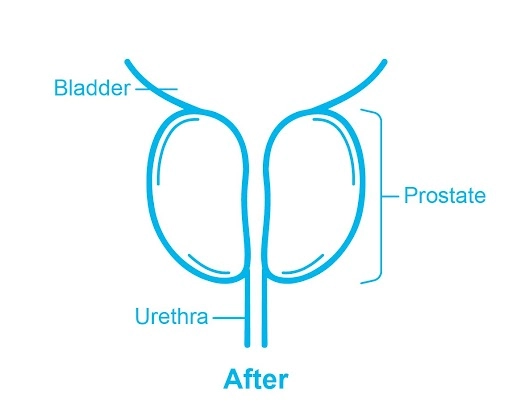
The prostate is a small gland found in males and plays a role in semen production. It is positioned beneath the bladder and in front of the rectum, wrapping around the urethra that transports urine and semen out of the body.
The prostate usually grows larger as a man ages. Some men may experience health issues caused by the prostate if it becomes overly enlarged.
Benign Prostatic Hyperplasia (BPH) is a non-cancerous enlargement of the prostate gland enlarged prostate. It is a common urological disorder in men over 50 years of age.
This enlargement of the prostate causes the urethra, the tube that passes the urine out of the penis, to be squeezed and narrowed. This blocks the passage of urine out of the bladder and more pressure is needed to pass urine.
The bladder starts to contract even when it is not completely full and eventually may lose its ability to empty itself. As the urethra is pinched, the bladder needs to work harder, causing the bladder muscles to become weak over time.
These signs are common benign prostatic hyperplasia symptoms:
The causes of BPH are not well known. BHP can occur due to the accumulation of the male hormone dihydroxytestosterone (DHT), which is a testosterone involved in the growth of the prostate. The cause of high levels of DHT is not yet understood.
It is thought that the hormonal imbalance that occurs with increasing age can be responsible for this condition.
Following are the risk factors of BPH:
If BPH is left untreated, it can cause further blockage in your urethra, and your symptoms may deteriorate. Untreated BPH may also cause:
A bladder that is not fully empty can expand and weaken over time, indicating bladder damage. This results in the bladder’s muscular wall being unable to adequately squeeze to force urine out, making it harder to empty the bladder completely.
Urethral stricture on the other hand is a narrowing of the urethra. It is the tube that transports urine from the bladder through the penis and out the urethral meatus (the opening at the tip of the penis) during urination. Many men with urethral stricture will experience escalating discomfort with urinating and a slowing of the urinary stream. This can occur slowly and result in the need to exert extra pressure or effort to get urine out. A weakened urinary system is the most common symptom of urethral stricture.
Bladder stones are solid clumps of minerals that develop in your bladder. They form when urine stays in your bladder for a long time. If you have bladder stones, the most common symptom you will experience is abdominal pain, but it can also cause issues when urinating.
The inability to urinate causes pressure in the bladder, harming the kidneys or increasing the odds of bladder infections reaching the kidneys.
Kidney infections, also known as pyelonephritis, is a type of urinary tract infection that typically shifts from your bladder to your kidneys. What causes kidney infections is commonly bacteria. Fever, trouble peeing, lower back pain, and pain when you pee are common symptoms of a kidney infection. Infections like these are treated with antibiotics.
Urinary incontinence (UI) means losing control of your bladder or having the inability to control urination. This is a common condition and can vary from being a small problem to a condition that severely impacts your everyday life. However, urinary incontinence can improve with proper treatment and care.

Men who have BPH may also experience erectile dysfunction and ejaculatory problems. Although BPH does not create these problems on its own, some of the treatments used for BPH can cause erectile dysfunction.
According to research, having BPH does not raise your risk of developing prostate cancer. However, both BPH and prostate cancer share similar symptoms. If you have BPH, it is possible that you have undetected prostate cancer as well, please consult a doctor as soon as possible.
Your doctor will go through your medical history, ask you relevant questions, and conduct a physical examination. A digital rectal exam is often part of the physical examination.
During the examination, your doctor will carefully insert their gloved finger into your rectum during a digital rectal exam. They will feel the edges and surface of your prostate, estimate your prostate’s size, and identify any hard spots that could be cancer.
Your doctor may also order:
There are a few treatments available to treat BPH. Your doctor will evaluate your condition and suggest the best treatment, depending on your age, the severity of BPH, and your general health. The treatment options include:



Here are a few benefits of Rezum Vapour Therapy:
This includes two broad categories of medication:
This treatment is for patients with smaller prostate glands, whereby laser energy is delivered, through the urethra, to the prostate gland in order to destroy tissue that is contributing to the enlarged prostate.
This treatment removes the enlarged parts of the prostate that are pressing against the urethra. There are different surgical methods that can be used:
Making lifestyle changes that improve your prostate and heart health is the most effective methods to lower your risk of getting BPH.
Exercising at least half an hour each day may help prevent BPH or slow the growth of the prostate. What is important is maintaining normal cholesterol, blood pressure, and blood sugar levels.
Read more: Health Conditions Men Should Be Aware Of
Speak to our doctors if you are experiencing any symptoms of Benign Prostatic Hyperplasia (BPH). A dedicated and expert team of Urologists at Pantai Hospitals is available for consultation to provide the best care and assistance.
Visit the nearest Pantai Hospital to learn more about the Water Vapour Therapy (Rezūm) treatment.


Speak to our doctors if you are experiencing any symptoms of Benign Prostatic Hyperplasia (BPH). A dedicated and expert team of Urologists at Pantai Hospitals is available for consultation to provide the best care and assistance.
Pantai Hospital has been accredited by the Malaysian Society for Quality in Health (MSQH) for its commitment to patient safety and service quality.
Book Now
